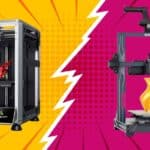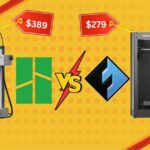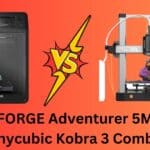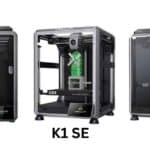
The Creality Ender 3 V3 SE wins for its speed, affordability, and beginner-friendly design, while the Ender 3 Max Neo offers a larger build volume for those willing to spend more.
3D printing is no longer just for tech enthusiasts—it’s for creators, hobbyists, and even families looking to bring their ideas to life. But with so many options, choosing the right printer can feel overwhelming. There are Creality Ender 3 V3 SE and the Ender 3 Max Neo, two popular models that cater to different needs. In this Creality Ender 3 V3 SE vs Creality Ender 3 Max Neo article, we’ll dive deep into their features, user experiences, and quirks to help you decide which one deserves a spot in your workspace. Spoiler: One is a speed demon, while the other is a reliable workhorse. Let’s find out which one suits you best.
Affiliate Disclosure
We participate in Amazon affiliate programs, earning fees from qualifying purchases via links at no extra cost to you. It’s how we keep this blog rolling and my 3D printers buzzing with fresh filament for reviews like this one!
Related: Creality Ender 3 V3 SE vs FLASHFORGE Adventurer 5M: Which Budget 3D Printer is Better?
Creality Ender 3 V3 SE vs Creality Ender 3 Max Neo
Key Features
Creality Ender 3 V3 SE
- Print Speed: Up to 250mm/s with 2500mm/s² acceleration—perfect for impatient creators.
- Build Volume: 220 x 220 x 250mm—compact but capable.
- Auto Leveling: CR Touch and strain sensor for auto Z-offset—no more manual bed leveling headaches.
- Extruder: “Sprite” Direct Extruder—smooth feeding for PLA, PETG, and TPU.
- Dual Z-Axis: Stable structure with timing belt synchronization—reduces wobbling for precise prints.
- UI: Intuitive motion graphics display—easy to monitor and use.
- Filament Handling: Auto loading and unloading—effortless filament changes.
- Price: $259—affordable for beginners and hobbyists.
Creality Ender 3 Max Neo
- Print Speed: Up to 150mm/s—slower but steady.
- Build Volume: 300 x 300 x 320mm—ideal for larger projects.
- Auto Leveling: CR Touch for 25-point auto bed leveling—consistent first layers.
- Extruder: Full-metal Bowden extruder—durable and reliable.
- Dual Z-Axis: Dual motors and timing belts—ensures stability and precision.
- UI: 4.3-inch color knob screen—user-friendly and energy-efficient.
- Filament Sensor: Detects filament sufficiency—prevents mid-print failures.
- Price: $309—slightly pricier but packed with features.
Related: Creality K1 SE vs Creality K1C 3D Printer: Which One Is Better
Real User Experiences
Ender 3 V3 SE: The Speed Demon
- Positive Feedback:
- Jabir Patel raves about its speed, calling it a “75% faster upgrade” from the Ender 3 Pro. He praises its elegant design and beginner-friendly features.
- LintLicker shares how his 13-year-old son fell in love with the printer, downloading free prints and enjoying seamless printing.
- Damon Abdon highlights its ease of setup, with the printer ready to go in just 20 minutes.
- Negative Feedback:
- Amazon Customer had a nightmare experience with firmware issues, leading to a non-functional printer after just two rolls of filament.
- Brittany H. struggled with print quality, citing issues with wall adhesion and Z-axis alignment.
Ender 3 Max Neo: The Reliable Workhorse
- Positive Feedback:
- Brian Hunter, a seasoned 3D printing expert, calls it an “AWESOME PRODUCT” and praises its ease of use and print quality.
- Tim H. owns three Ender 3 Max Neo printers and swears by their reliability, especially after upgrading components like the PEI sheet and Capricorn tubing.
- David Cowsert was pleasantly surprised by the glass bed, which he now prefers over magnetic beds.
- Negative Feedback:
- Paul H. faced multiple DOA (dead on arrival) units, with issues ranging from Z-axis misalignment to power supply failures.
- Damian Dodge notes a moderate learning curve and occasional print failures but overall finds it a solid workhorse.
Similarities
- Auto Leveling: Both feature CR Touch for hassle-free bed leveling.
- Dual Z-Axis: Ensures stability and precision in prints.
- Silent Mainboard: 32-bit silent mainboard for quieter operation.
- Filament Compatibility: Supports PLA, PETG, and TPU.
- Ease of Assembly: Both are 90% pre-assembled and beginner-friendly.
Differences
| Feature | Ender 3 V3 SE | Ender 3 Max Neo |
|---|---|---|
| Build Volume | 220 x 220 x 250mm | 300 x 300 x 320mm |
| Print Speed | 250mm/s (faster) | 150mm/s (slower) |
| Extruder | Direct “Sprite” Extruder | Full-metal Bowden Extruder |
| Filament Handling | Auto loading/unloading | Manual loading, filament sensor |
| Price | $259 (more affordable) | $309 (higher upfront cost) |
Pros and Cons
Ender 3 V3 SE
Pros
- fast print speed (250mm/s).
- Auto filament loading/unloading—great for beginners.
- Affordable price point.
- Compact design, ideal for small spaces.
Cons
- Smaller build volume limits larger projects.
- Some users report firmware and quality control issues.
Ender 3 Max Neo
Pros
- Larger build volume for bigger prints.
- Full-metal extruder for durability.
- Filament sensor prevents mid-print failures.
- Glass bed for better adhesion.
Cons
- int speed (150mm/s).
- Higher price point.
- Manual filament loading can be cumbersome.
Who This Is For
- Ender 3 V3 SE:
- Beginners and hobbyists looking for an affordable, fast, and easy-to-use printer.
- Users with limited space who need a compact machine.
- Those who prioritize speed over build volume.
- Ender 3 Max Neo:
- Hobbyists and professionals needing a larger build volume for bigger projects.
- Users who value durability and precision over speed.
- Those willing to pay a premium for advanced features like a filament sensor and glass bed.
Who Should Avoid
- Ender 3 V3 SE:
- Avoid if you need to print large models or multiple parts simultaneously.
- Not ideal for advanced users who require a Bowden extruder for specialized filaments.
- Ender 3 Max Neo:
- Avoid if you’re on a tight budget or need faster print speeds.
- Not recommended for beginners who may find the larger size and manual filament handling cumbersome.
Frequently Asked Questions (FAQs)
Which printer is better for beginners?
The Ender 3 V3 SE is more beginner-friendly due to its auto filament handling and faster setup.
Can both printers handle TPU filament?
Yes, both support TPU, but the Ender 3 Max Neo’s full-metal extruder may handle it more reliably.
Which printer has better print quality?
Both offer excellent quality, but the Ender 3 Max Neo’s larger build volume and glass bed may provide slightly better results for larger prints.
Is the Ender 3 Max Neo worth the extra cost?
If you need a larger build volume and advanced features like a filament sensor, it’s worth the investment.
Can I upgrade these printers?
Yes, both are highly upgradeable, but the Ender 3 Max Neo has more room for customization due to its larger size.
Final Verdict
Based on a weighted points system (speed, build volume, ease of use, features, and price):
- Ender 3 V3 SE: 9/10 – Best for beginners and those prioritizing speed and affordability.
- Ender 3 Max Neo: 8.5/10 – Ideal for users needing a larger build volume and advanced features.
Winner: The Creality Ender 3 V3 SE takes the crown for its speed, affordability, and beginner-friendly features. However, if you need a larger build volume and don’t mind the higher price, the Ender 3 Max Neo is a solid choice.















